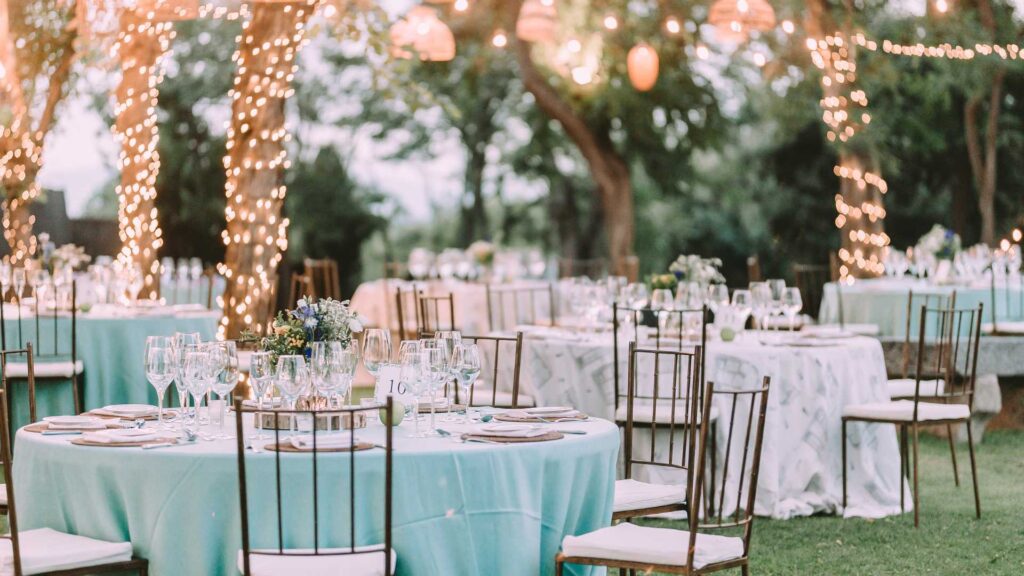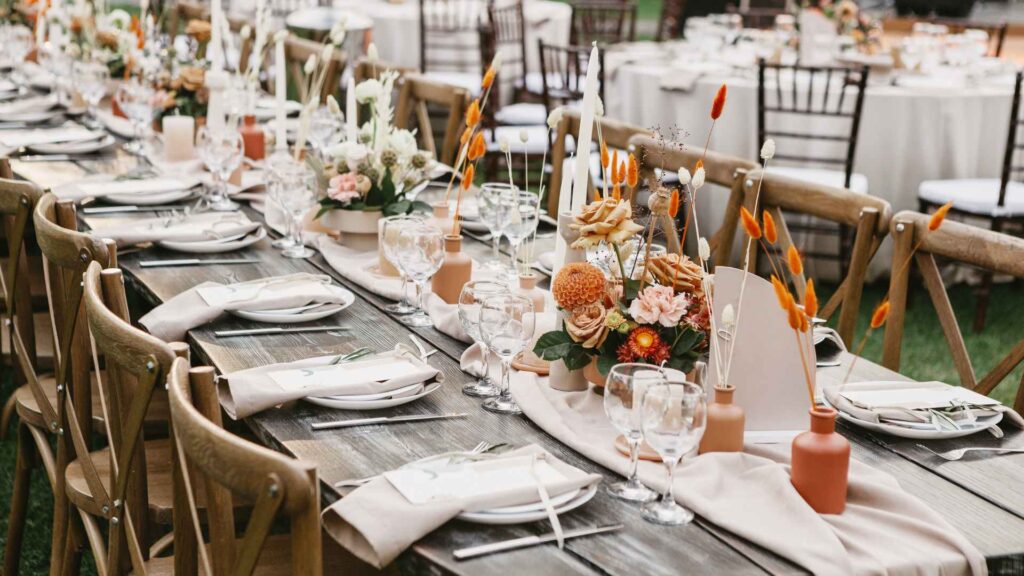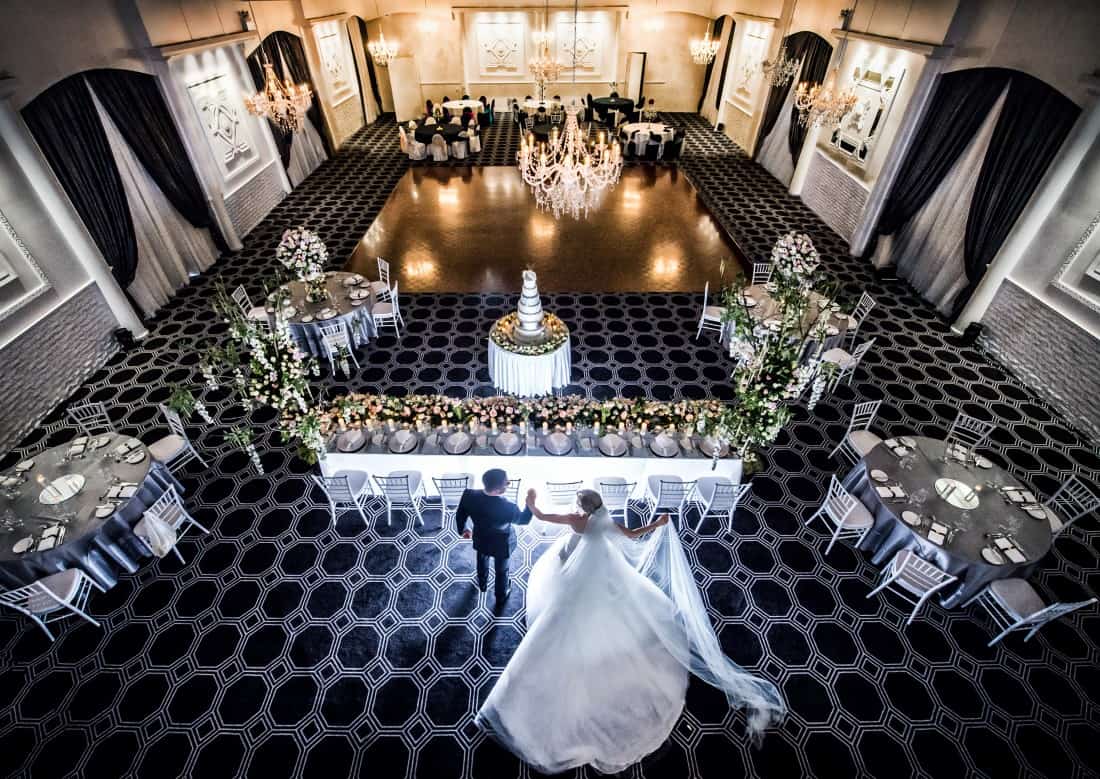Planning a wedding reception can be challenging, especially when considering every detail that contributes to the flow of the day. The pandemic has only added complexity, making it difficult to plan a wedding timeline that keeps everything running smoothly. While we can’t simplify the world, we can help guide you through one of the key aspects of your wedding day—creating a timeline that ensures your reception is a success.
Summary
A well-organised wedding timeline is essential for a smooth, stress-free day. Plan your ceremony, reception, and after-party in detail, considering everything from the cocktail hour to the grand exit. A typical wedding lasts 6-8 hours, with key moments like the first dance, toasts, and cake cutting carefully timed. Ensure your timeline accounts for any travel between venues if necessary. After the reception, consider an after-party if you want to keep the celebration going. Proper planning ensures you and your guests enjoy every moment of your special day.
How Long Should A Wedding Last?
Weddings generally last between six and eight hours. This includes the ceremony, the reception, and special activities or photo sessions. The ceremony usually takes about an hour, and the reception can last four to five hours if everything is at the same location; every minute counts. If there’s travel involved, you’ll need to adjust your schedule accordingly.
A Typical Wedding Reception Timeline
1. Cocktail Hour
After the ceremony, guests typically enjoy a one-hour cocktail reception. This is the perfect time for your guests to relax and socialise while you and your partner take formal photos with your family. Even though you won’t be present, your guests will appreciate the opportunity to unwind before the reception begins.
2. Seating Guests In The Reception Area
Once cocktail hour is over, your DJ or host will guide guests to their seats. Depending on the number of attendees, it’s important to include when you expect guests to start taking their seats and how long you think this process will take.
3. Grand Entrance Of The Wedding Party
The grand entrance is one of the most exciting moments of the reception. Your DJ/MC will announce the wedding party’s arrival, building anticipation for the bride and groom’s entrance. Some couples enter with a fun dance or other creative movements that set the tone for the rest of the night.
4. The First Dance
Once you’ve entered, it’s time for your first dance as a married couple. This is a special moment, whether you’ve choreographed a dance or are simply swaying to a meaningful song. The first dance is a reception highlight and should be placed in your timeline.
5. Toast Of Welcome
After your first dance, it’s time to welcome your guests formally. This is often done with a toast by the couple or a close family member, such as the bride’s parents. This is also a good moment to say grace if that’s part of your tradition before the meal begins.
6. Dinner Is Served
Dinner is your chance to enjoy the meal you’ve carefully selected for your wedding. You’ll likely be served first, giving you time to eat quickly and mingle with your guests. If you plan to visit each table to greet guests and take photos, ensure you allocate enough time in your timeline.
7. Toasts
Toasts are a traditional way to honour the couple during dinner. The Best Man and Maid of Honour typically start the toasts, followed by other close family members or friends. This is another opportunity if you still need to thank your guests earlier.
8. Family Dances
Family dances, such as the mother-son and father-daughter dances, are a wonderful way to transition into the dancing portion of your reception. These dances often inspire other guests to join in, filling the dance floor and setting the stage for the evening’s festivities.
9. Dessert and Cake-cutting
The cake cutting usually happens about an hour before the reception ends or your planned exit. This signals to your guests that the evening is winding down. The DJ might play softer music as the cake is served, creating a relaxed atmosphere as everyone enjoys dessert.
10. Evening Photo Session
Before the night ends, you and your partner should sneak away for a quick photo session, especially if there’s a beautiful sunset. This is a chance to capture a few more romantic moments before the night ends. Coordinate with your photographer to ensure this fits into your timeline.
11. Dance Party
After dessert, it’s time to get the party started! The best way to kick off the dance floor is with a high-energy song that gets everyone moving. You can plan fun activities like the garter toss or bouquet throw during the dance party, mixing in some slower songs to allow everyone to catch their breath.
12. Grand Exit
Finally, as the night ends, plan for a grand exit. After the last song, your DJ/MC will guide everyone outside to send you off. Whether with sparklers, bubbles, or another creative exit, this is the perfect way to end your wedding reception on a high note.
Why You Need A Wedding Day Timeline?
You might think smoothly running weddings is just a matter of luck, but there’s much planning behind the scenes. A well-organised timeline is the secret ingredient that makes a wedding feel effortless. When everything is planned out—from when and where things happen to how long each part should take—the day flows seamlessly for everyone involved.
The Importance Of Preparation
Preparation is the key to a stress-free wedding day. A detailed timeline breaks down the day into manageable parts, ensuring each event happens correctly. Whether your wedding ceremony lasts 30 minutes or an hour and whether your reception is four or five hours long, a solid plan will keep things on track.
If your wedding and reception are at the same location, your timeline will be simpler. However, if your reception is in a different location, you must account for travel time to ensure your guests can move from one event to the next without feeling rushed.
The Two Phases Of A Wedding Day
Your wedding day typically consists of two main phases: the ceremony and the reception. The ceremony is where you and your partner exchange vows and officially begin your life together. The reception is your opportunity to celebrate this union with your loved ones.
While the ceremony is significant, many couples focus more on the reception since it’s the time to celebrate with family and friends. However, if your ceremony will be elaborate, you should give it more attention in your timeline.
After The Reception: Keeping The Party Going
Sometimes, the party doesn’t have to end just because the reception is over. Consider planning an after-party if you and your guests need more time to prepare for the night. Depending on the options available, this could be at a local bar, a hotel room, or even another part of your venue.
While your hotel room should be a place to rest, no rules exist against continuing the celebration elsewhere. Just make sure to consider everyone’s energy levels after a long day.
Conclusion
Creating a detailed wedding day timeline is important for ensuring that your special day goes off without a hitch. From the ceremony to the reception and even the after-party, carefully planning each part of your wedding day will help you and your guests enjoy every moment.
Remember that your wedding celebrates your love with those who matter most. By staying organised and sticking to your timeline, you’ll create a day that’s as memorable as it is enjoyable.
If you need help planning your wedding reception, Vogue Ballroom in Melbourne offers a stunning venue and experienced staff to help bring your vision to life. Whether you’re planning a grand entrance, an unforgettable first dance, or a fun-filled dance party, their team can assist you in creating the perfect timeline for your wedding day.
FAQs About Wedding Reception
What Factors Should Be Considered When Deciding the End Time for a Wedding Reception?
Consider guest comfort, venue policies, local noise ordinances, the flow of events, and whether you have entertainment or activities planned for the evening.
How Can I Determine the Ideal End Time for a Wedding Reception to Accommodate All Guests?
Aim for a time that allows for the full range of planned activities, including dinner, dancing, and speeches, while ensuring guests, especially those with early commitments, can stay for the key moments.
Is It Common for Wedding Receptions to End Earlier or Later on Weekdays Compared to Weekends?
Yes, receptions often end earlier on weekdays due to work commitments the next day, while weekend receptions can extend later into the evening.
What Are the Pros and Cons of Having a Late-Night Wedding Reception?
A late-night reception can allow for more time to celebrate and enjoy, but it might be challenging for older guests or those with early obligations. Ensure you have ample food and beverage options.
How Do I Handle the Reception End Time if the Venue Has Specific Closing Hours?
Check with the venue about their closing hours and plan your timeline accordingly. If you wish to extend the celebration, discuss options for overtime or additional fees with the venue in advance.



